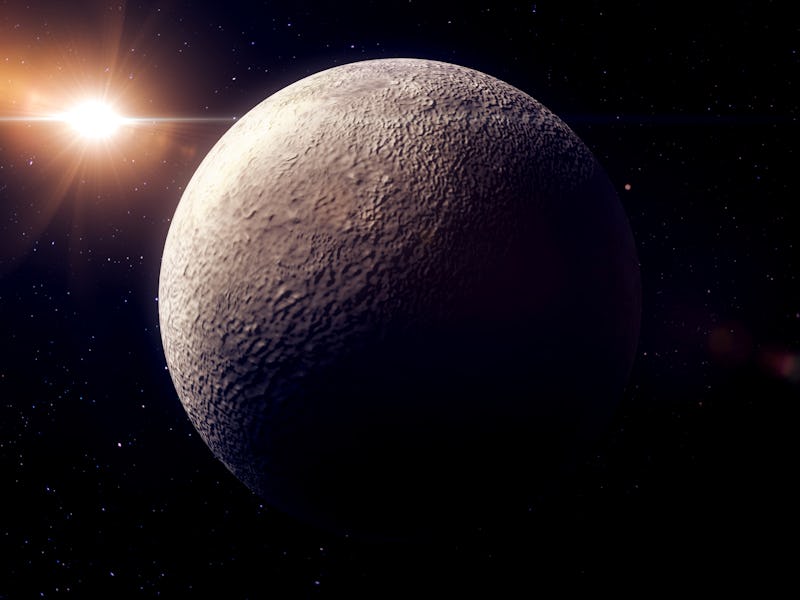Astronomers Found A Ring Around A Distant Object In Space — And It’s Acting Strange
This icy rock beyond Neptune has a ring, and it's raising some questions.

While an object the size of Spain drifts through the distant Solar System, astronomers watch it block faraway starlight to gather information. Recently, they found something exciting: this primordial chunk has a ring.
This is a show-stopping feature of Saturn and other planets, but much smaller bodies have them too. A decade ago, this same team made the first-ever detection of a ring around an asteroid.
The history-making space rock, Chariklo, is still being studied. In fact, last month, two papers detailed how the new James Webb Space Telescope helped to reveal more details. And in 2017, they found the rings around the faraway dwarf planet Haumea. But their latest findings, published Wednesday in Nature, suggest an unexpected situation: The newly-discovered ring looks like it is in the wrong place.
This illustration shows where outer Solar System bodies have their moons and rings. The yellow line represents the Roche limit, a region where rings typically form and beyond which moons are expected.
What the researchers did
The ring belongs to Quaoar, a 1,110-kilometer-wide icy rock located about 43 times farther away from the Sun than Earth’s orbit. This distant region beyond Neptune is full of material that Bruno Morgado, lead researcher and astronomer at Brazil’s Federal University of Rio de Janeiro, describes as “bricks” of the Solar System as we see it today. To learn about these building blocks, Morgado and his team used a special technique where they watch for periodic dimming of distant starlight, called stellar occultation.
“It’s very similar to an eclipse: We have a star, a very faraway star, and this small body just passes in front of the star from [the perspective] of the observer, and this casts a shadow here on Earth. So if you are in the right place at the right time, you’ll see the star just blink, disappear for a couple of seconds, and then come back to its full brightness,” Morgado tells Inverse.
The team benefits from multiple sources and angles. Their eclectic mix of observations, taken from 2018 to 2021, includes a few minutes of observation time from the European Space Agency’s exoplanet-hunting Cheops spacecraft. Missions that search for planets outside the Solar System often employ the transit method, where they look for brief moments of dimming when a planet passes in front of its parent star.
What this finding means — and why it’s important
“Quaoar’s ring is not where we expected it to be,” Morgado says.
Planets and asteroids have moons, rings, or both. The Roche limit is an explanation for why one or the other forms, but it doesn’t justify the ring around Quaoar.
An illustration of dwarf planet Haumea, its ring, and two moons.
“If you have a satellite that goes inside this limit, the satellite will break and become a ring… due to the gravitational forces, the tidal forces,” Morgado says. (Here, “satellite” refers to a natural object, like a moon, that orbits something bigger. No robotic explorers.) “And the other way around, if you have a ring that goes outside the Roche limit, this ring will start to accrete, and it starts to become a satellite.”
This misalignment of theory and data means that perhaps the Roche limit needs to be modified. Or, there’s some unknown force acting on the ring to keep it in an unusual spot.
Although very unlikely, but interesting if true, the team might be catching the ring becoming a moon. But that would be an astronomer’s version of hitting the jackpot: incredible but very rare.
What’s next for the research
The finding raises questions, and more research is needed to figure out what exactly they’re witnessing.
“At first I was skeptical, as the ring is not where we would expect,” Felipe Braga-Ribas, co-author of the new study, lead researcher of the Chariklo ring discovery and professor at Brazil’s Federal University of Technology in Paraná, tells Inverse.
As the data poured in, Braga-Ribas felt delighted and “intrigued.” The team might ride this momentum.
“Every object studied in detail using the stellar occultation technique has something particular about it, something that we were not expecting,” Braga-Ribas says. “So I can not say what else we will discover, but I am sure that more exciting results will come.”